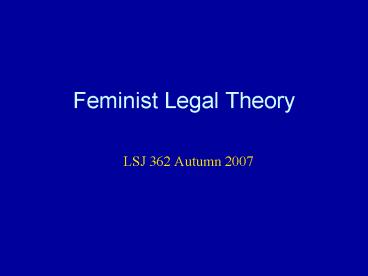Feminist Legal Theory - PowerPoint PPT Presentation
1 / 14
Title:
Feminist Legal Theory
Description:
This wave' of feminism dates from the enlightenment (eighteenth ... 'central problems of battering male violence, male power, and gender hierarchy' (332) ... – PowerPoint PPT presentation
Number of Views:832
Avg rating:3.0/5.0
Title: Feminist Legal Theory
1
Feminist Legal Theory
- LSJ 362 Autumn 2007
2
- The laws apparent neutrality masks its real
nature the law is male.
3
First Wave Feminism EQUALITY
- This wave of feminism dates from the
enlightenment (eighteenth-century) and stresses
equality, rights, liberation and emancipation. - First wave feminism insists that gender is
inessential or secondary to our humanity - John Stuart Mill was a first wave feminist
4
Second Wave Feminism DIFFERENCE
- Second wave feminism (or difference feminism)
stresses the difference between sex and gender
sex is our biological and natural being gender
is the social and cultural interpretation of that
being. - Equality relies on being equal to some
standard, a standard usually associated with
masculinity and masculine ideals. - Second wave feminism stresses the difference of
women, and challenges the centrality of masculine
values (reason, detachment, power, autonomy,
aggression).
5
Second Wave Feminism DIFFERENCE
- Carol Gilligan In a Different Voice
- Catharine MacKinnon
- The law reifies male dominance
- Criticizes sameness/difference theory used to
frame womens rights under the law in terms of
their sameness to men (e.g. deserving equal pay)
or their difference from men (e.g. right of
maternity leave) - problematic because both sameness and difference
use men as the referent category
6
Second Wave Feminism DIFFERENCE
- Catharine MacKinnon
- makes it difficult for women to argue for special
protection under the law when the underlying
premise is equal treatment makes it seem like
women want it both ways - the real question is not whether women are like,
or unlike, men, but whether a rule or practice
serves to subordinate women to men - law defines sex and sexual difference in ways
that mask the universality of men's point of view
and naturalize women's relative powerlessness in
society
7
Second Wave Feminism DIFFERENCE
- Catharine MacKinnon
- -right to privacy or free speech sanction
spaces in which men can abuse women (domestic
violence, pornography)
8
Second Wave Feminism DIFFERENCE
- Elizabeth Schneider, "The Violence of Privacy
- public/private divide
- opposed to mediation in violence against women
cases, instead wants criminalization, because
mediation is a "private" solution, criminal
sanctions send public message of condemnation
9
Second Wave Feminism DIFFERENCE
- Christine Littleton, Womens Experience and the
Problem of Transition - 1 ) The law's approach to the problem of violence
against women accepts violence against women,
focusing on individual choices (was it safe to
leave? etc.) rather than on structural problems
in society - This translates the problem into a problem of
individual womens decisions rather than the
central problems of battering male violence,
male power, and gender hierarchy (332)
10
Second Wave Feminism DIFFERENCE
- Christine Littleton
- 2) Separation/connection
- The problem of transition is created by an
existing system of power that makes any
non-conforming patterns of behavior appear
deviant Phallocentrism is just such a hegemonic
system. It systematically rewards those who
conform to culturally male styles of behavior and
systematically disadvantages those who resist,
regardless of the biological sex of the actor.
(p. 333) - Male jurisprudence separates, yet women seek
connection to others --gt are there ways we can
envision solutions to violence against women that
respect womens desire for safe connection rather
than forcing women to adhere to (male) standards
for reasonable behavior?
11
Third Wave Feminism DECONSTRUCTION/
POSTMODERNISM
- Criticism of 2nd wave for essentializing gender
- The supposed opposition between masculine and
feminine can also be deconstructed. Third wave
feminism looks at how the difference between men
and women is constructed and performed. - Instead of the sex/gender distinction or the
assertion of a common humanity, third wave
feminism stresses polymorphous difference not a
difference between men and women, but a continual
and unstable difference.
12
Third Wave Feminism
- Rejects the binary model there are not two
sexes but a series of sexual identifications and
performances. There is no natural sex
underlying our gender. - Sex and gender are textual or performative --
always in production and open to question - Supports the ideal of personhood, as opposed to
a strong, exclusive sense of identity as women
point isnt to reverse the socially constructed
hierarchy so that women are on top, or to
institute special protections for women, but to
renegotiate all human relations so power is
shared
13
Third Wave Feminism
- Wendy Brown, States of Injury
- Danger of asking state to provide protection for
women in doing so, may reflect and reinforce the
very attitudes which perpetuate inequities. - Example 1981 Supreme Court case, Michael M. v.
Sonoma County, upheld Californias statutory rape
law (had been challenged on equal protection
grounds) - Drucilla Cornell statute embodies and reinforces
assumptions about gender that cause harm - The Court refuses to examine the role that the
law plays in reinforcing the very values that
cause injuries to women.
14
Third Wave Feminism
- Also critical of 2nd wave for failing to address
other forms of oppression, especially race - Black feminism in USA, Postcolonial or third
world feminism































